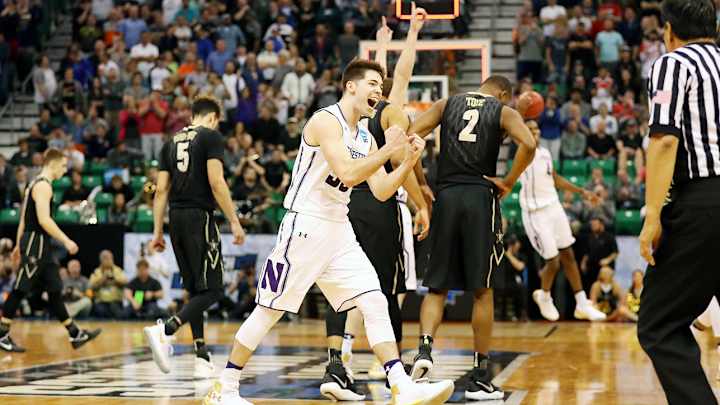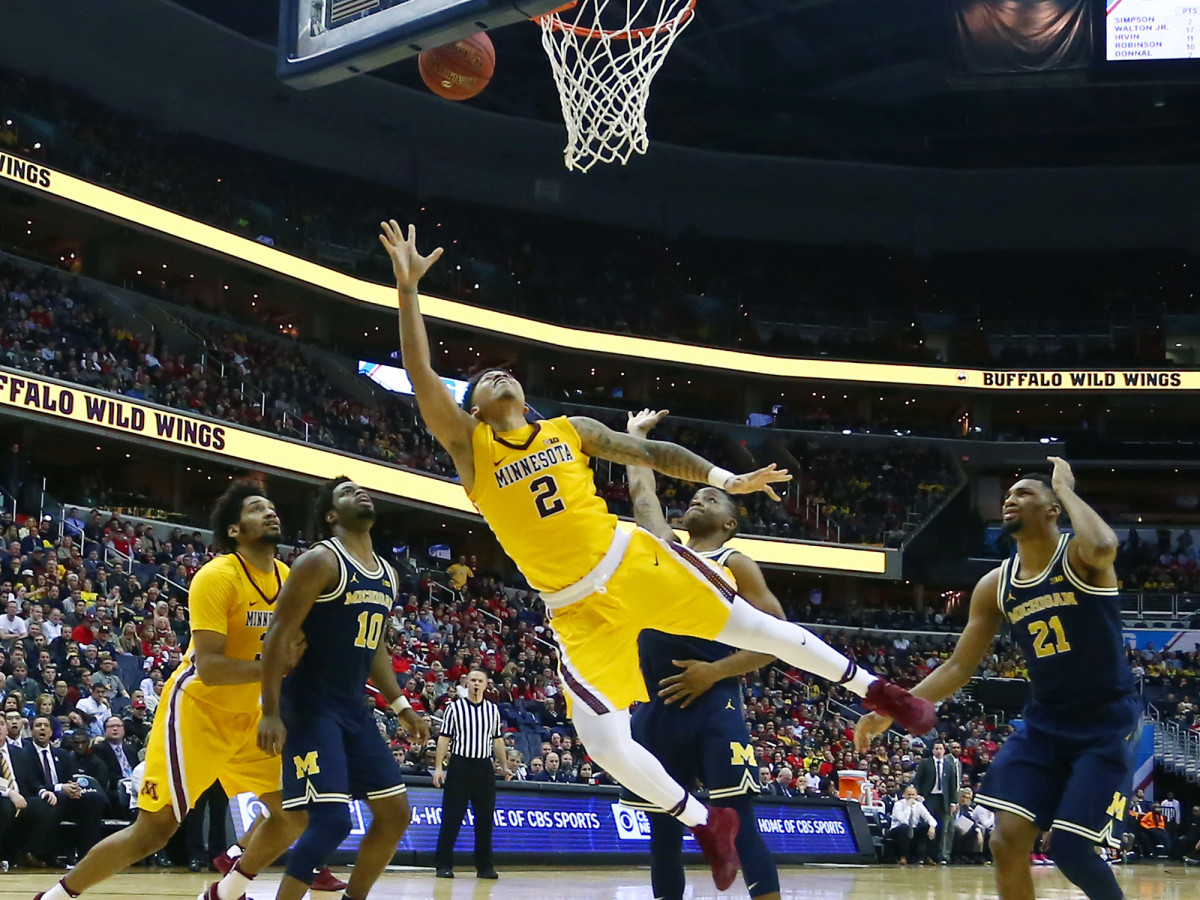Season in review: Big Ten

The NCAA tournament tends to obscure everything that came before it in a given college basketball season. Which teams won those Thanksgiving-week nonconference tournaments? Which players were making compelling cases for national awards in December and January? The image of Kennedy Meeks, Justin Jackson, Joel Berry II, Isaiah Hicks and other North Carolina Tar Heels cutting down the nets in Glendale moments after a six-point win over Gonzaga in the title game won’t fade away soon, but in the meantime, it’s worth looking back at what else happened during the 2016–17 campaign. This is the fifth installment of a conference-by-conference review series. We’ve already reviewed the ACC, Big 12, AAC and Big East. Here’s the Big Ten.
Most important thing we learned: An irregular season for the Big Ten likely affected its postseason fate
The conference is still searching for its first national title since Michigan State in 2000 (Maryland’s 2002 championship came when the school was still a member of the ACC), and for the second year in a row it didn’t come close to breaking the drought. The Big Ten was the only conference in the “Big Six” to not advance a team past the Sweet 16 and the only one to not have a top-10 team in the final AP poll. The NCAA tournament is so unpredictable that it shouldn’t be overly read into—had Chris Chiozza’s game-winning heave not fallen, for example, Wisconsin would have danced into the Elite Eight—but the conference’s uneven season resulted in a strange Selection Sunday.
Some of the most surprising reactions that day came in relation to Big Ten teams and where they wound up seeded, most notably 27–10 Wisconsin receiving a No. 8 seed. It seemed like the NCAA selection committee had a tough time gauging several Big Ten teams after a season that largely diverted from expectations, leaving people wondering how the second-place Badgers received the same seed as sixth-place Northwestern, or why there was a three-seed gap between the Badgers and fourth-place Minnesota (which got a No. 5 seed) yet just a one-seed gap between them and seventh-place Michigan State (a No. 9 seed). Wisconsin validated the claims of underseeding by knocking off No. 1 seed Villanova, but in the end the Big Ten didn’t have the postseason success it had hoped for.
Way-Too-Early Top 25 rankings for the 2017–18 college basketball season
Best game: Northwestern 67, Michigan 65 (March 1, 2017)
You may have heard that a school from Evanston, Ill., earned its first-ever NCAA tournament berth this March. The Wildcats may have sealed that bid in dramatic fashion with their buzzer-beating win over the Wolverines in their penultimate regular-season game.
After a back-and-forth nearly 40 minutes, the game seemed destined for overtime when Northwestern called timeout with 1.7 seconds remaining in regulation. The Wildcats had to inbound from under their own basket—not exactly ideal conditions for a Hail Mary attempt. But Nathan Taphorn did his best Aaron Rodgers impression and heaved the ball the full length of the court, somehow connecting with Dererk Pardon, who had just enough time to lay the ball off the backboard and beat the buzzer, sparking bedlam at Welsh-Ryan Arena.
Best player: Caleb Swanigan, Purdue
“Biggie” Swanigan, as he’s affectionately called, had a monster year for the Boilermakers after passing on the NBA draft following a strong freshman season. His decision to return to school proved astute, as the 6’9” big man improved his numbers across the board, taking control of Purdue’s offense and leading the Boilermakers to the Big Ten regular-season title and the Sweet 16.
Swanigan finished second in the nation in rebounding (12.6 per game) and third in defensive rebounding rate. His 18.5 points per game were second in the conference, and he averaged 3.1 assists to boot. Perhaps Swanigan’s biggest improvement came in his shooting. His field-goal percentage rose from 46.1% to 52.7%, and his three-point percentage climbed all the way to 44.7% (sixth in the Big Ten) from 29.2% in 2015–16. That was all despite attempting nearly four more shots per game. A key difference was that sophomore Swanigan took a higher percentage of shots in the paint, which also led to a significant rise in his free-throw rate (33.3% to 49.9%, per kenpom.com).
Winners and losers of NBA draft early-entry deadline
Best coach: Northwestern’s Chris Collins
Collins was able to do something that no other coach in Northwestern history could do—get the team to the NCAA tournament. His 2016–17 coaching job was four years in the making; it started back in 2013 when he took the job and convinced Drew Crawford to stick around for his fifth season, salvaging what became a 14-win campaign that would serve as a building block for the next three.
It all finally came together this year for Collins and the Wildcats, with Bryant McIntosh and Scottie Lindsey taking the reigns as juniors and sophomores Vic Law and Dererk Pardon and freshman Isiah Brown serving as key role players. And then there was glue guy Sanjay Lumpkin, a fifth-year senior who had been at Northwestern even longer than Collins and made his most productive season his last. Collins had constructed the kind of balanced roster that would finally lead the Wildcats to the Promised Land where, playing with house money, they beat Vanderbilt to earn the school’s first NCAA tournament victory.
Best newcomer: Miles Bridges, Michigan State
Perhaps the most surprising NBA draft decision of the off-season came when Bridges, thought to be a potential lottery pick, announced that he would return to East Lansing for his sophomore season. Michigan State’s 2016–17 campaign didn’t go the way many expected, but Bridges lived up to his lofty recruiting ranking as a freshman, leading the Spartans in scoring (16.9 ppg), rebounding (8.3 rpg) and blocks (1.5 bpg) while adding 2.1 assists and shooting 48.6% from the field and 38.9% from three. According to kenpom.com, Bridges’s 24.6% defensive rebounding rate ranked sixth in Big Ten play while his 6.8 defensive rebounds per game ranked third.
Bridges’s return puts Michigan State as the early favorite in the Big Ten, as he rejoins fellow standout freshman Nick Ward and a young core that also includes Joshua Langford, Cassius Winston and incoming five-star recruit Jaren Jackson.

Biggest surprise: Minnesota
The success of the Golden Gophers in 2016–17 caught many off guard. SI.com’s preseason projections put Minnesota 97th overall and 13th in the Big Ten; kenpom.com had it 71st overall. The Gophers were coming off a dismal 8–23 season and losing four of their top six scorers.
But coach Richard Pitino made some savvy off-season additions, including signing top-40 recruit Amir Coffey and top-100 recruit Eric Curry and landing Milwaukee grad transfer Akeem Springs. Former Illinois State center Reggie Lynch also became eligible after sitting out the 2015–16 season. The roster turnover proved beneficial for Minnesota, as returner Nate Mason paired with Coffey to form a dangerous duo in the backcourt while Springs and Lynch served as valuable role players. Jordan Murphy continued his strong play as a sophomore and classmate Dupree McBrayer made a big jump from his freshman year.
Those six players, plus Curry, formed a rotation that helped Minnesota start the season 15–2, including a Jan. 1 win over Purdue that proved the team was for real. When the Gophers faltered during a 0–5 stretch that same month, Pitino was able to shake the team out of its doldrums, and it turned around with eight straight wins to ensure its first NCAA berth since 2013.
Biggest disappointment: Indiana
The Hoosiers began the 2016–17 campaign as a team that looked like it had Final Four potential, and that dream looked even more realistic after Indiana downed No. 3 Kansas in overtime in its season opener. Instead, a season that seemed like it could finally be the year for Tom Crean ended in his firing.
What happened? A Nov. 22 loss at Fort Wayne raised a few eyebrows, but it wasn’t until Big Ten play began that things truly fell apart for the Hoosiers. They lost their conference opener to Nebraska and followed it up by losing three of their next four, digging an early grave in the league title race.
In mid-January OG Anunoby underwent season-ending knee surgery, and James Blackmon Jr. would later miss a trio of games due to injury. In a brutal stretch in late-January and February, Indiana lost seven of eight, all but sinking its NCAA tournament hopes. Two days after a first-round loss in the NIT, Crean was swiftly fired, ending his nine-year tenure in Bloomington. Dayton’s Archie Miller was soon hired to try to right the ship.
One burning off-season question: Can Wisconsin keep its NCAA streak alive?
The Badgers have one of the nation’s longest active NCAA tournament streaks, having received a bid in each of the last 19 seasons. Notching a 20th, however, is no sure thing. Wisconsin, which just missed out on the Elite Eight courtesy of a buzzer-beater, loses Nigel Hayes, Bronson Koenig, Zak Showalter and Vitto Brown to graduation—that’s four starters and 61% of its scoring.
Replacing those four won’t be an easy task, but the good news is All-America Ethan Happ returns. Happ will need help, however, and it will need to come from the development of last season’s role players like D'Mitrik Trice, Khalil Iverson and Charles Thomas IV. The Badgers also bring in top-100 recruits Brad Davison and Nathan Reuvers, plus three-star recruit Kobe King.
Wisconsin has been in a similar situation before, just two years ago when it lost Frank Kaminsky and Sam Dekker after the duo had led the Badgers to back-to-back Final Fours. When Wisconsin lost to Western Illinois at home to open the following season, kicking off a rough start, it looked like the Badgers’ NCAA streak could be in jeopardy. But Hayes, Koenig and Happ led them all the way to the Sweet 16. The lesson here? Never underestimate the Badgers.
